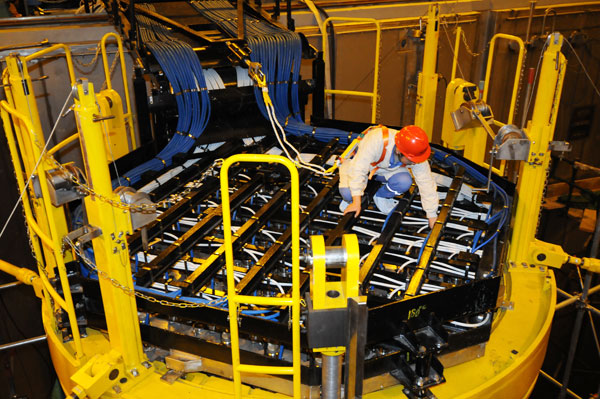


A technician works on the Hualong One reactor at the Fangchenggang nuclear power plant in the Guangxi Zhuang autonomous region. [Photo by Liang Fuying/For China Daily]
Flurry of projects set to gain approval, begin pending construction this year
After a three-year hiatus, nuclear energy efforts are set to go into the overdrive in China, with a few of projects expected to go on-stream or start to work this year, industry sources said.
China last approved a nuclear project in December 2015 and has since stopped approvals for construction of nuclear reactors.
According to Joseph Jacobelli, an independent energy analyst and Asia-Pacific CEO of clean energy producer Joule Power, nuclear power, which will help China reduce emissions and replace coal-fired plants, is expected to see renewed impetus in the next few decades.
China has charted plans to raise its total installed nuclear capacity to 58 gigawatts by 2020, while it also aims to have another 30 gigawatts under construction by the end of 2020.
Despite the suspension of approvals as well as delays in the commissioning of new generation reactors in recent years, China's target of cutting emissions and replace coal-fired plants should still be reached by 2021 or 2022, he said.
Jacobelli said he believed much of the strong nuclear power capacity growth will come from supportive environmental policies as China has mastered the independent design and manufacturing of third-generation nuclear power facilities after decades of learning and innovation.
The National Nuclear Safety Administration approved the debugging of two units in Fuqing Nuclear Power Plant on April 8, after the Ministry of Ecology and Environment released the operating license for units 1 and 2 of Taishan Nuclear Power Plant on April 4, the largest cooperation project between China and France in the energy sector, with two 1,750-megawatt EPR units in its first phase of construction.
Liu Hua, head of the National Nuclear Safety Administration, confirmed earlier that construction of nuclear projects will resume this year, after a three-year halt in approvals.
The unit 5 of China National Nuclear Corporation's Fuqing nuclear power plant has recently succeeded in inverse power transmission, laying a solid foundation for future fuel loading, power generation and transmission for the unit.
It is the nation's first demonstration nuclear power project using Hualong One technology, a domestically developed third-generation reactor, jointly designed by two domestic nuclear power giants-China General Nuclear Power Group and China National Nuclear Corp.

 Award-winning photos show poverty reduction achievements in NE China's Jilin province
Award-winning photos show poverty reduction achievements in NE China's Jilin province People dance to greet advent of New Year in Ameiqituo Town, Guizhou
People dance to greet advent of New Year in Ameiqituo Town, Guizhou Fire brigade in Shanghai holds group wedding
Fire brigade in Shanghai holds group wedding Tourists enjoy ice sculptures in Datan Town, north China
Tourists enjoy ice sculptures in Datan Town, north China Sunset scenery of Dayan Pagoda in Xi'an
Sunset scenery of Dayan Pagoda in Xi'an Tourists have fun at scenic spot in Nanlong Town, NW China
Tourists have fun at scenic spot in Nanlong Town, NW China Harbin attracts tourists by making best use of ice in winter
Harbin attracts tourists by making best use of ice in winter In pics: FIS Alpine Ski Women's World Cup Slalom
In pics: FIS Alpine Ski Women's World Cup Slalom Black-necked cranes rest at reservoir in Lhunzhub County, Lhasa
Black-necked cranes rest at reservoir in Lhunzhub County, Lhasa China's FAST telescope will be available to foreign scientists in April
China's FAST telescope will be available to foreign scientists in April